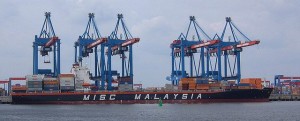Keeping Ahead of Proliferation Networks
Stephanie Lieggi and Diana Lee
May 20, 2015
Under a grant from the Naval Postgraduate School’s Project on Advanced Systems and Concepts For Countering WMD (PASCC), the James Martin Center for Nonproliferation Studies is examining the growing industrial and high-tech manufacturing capabilities in Southeast Asia and how, over the next decade, that growth may challenge global efforts to control the flow of dual-use technologies related to the development of weapons of mass destruction (WMD).
Increased Risk in Southeast Asia?

Malaysian Vessel at Container Terminal, Source: Wolfgang Meinhart, CC BY-SA 3.0 via Wikimedia Commons
While no state in the region has an active WMD development program, the industrial growth and technological progress within many of the members of the Association for Southeast Asian Nations (ASEAN) may provide a new set of suppliers for proliferating entities elsewhere in the world to choose from. A number of illicit trafficking networks, including the AQ Khan network, have already used companies and brokers in the region for the manufacturing and acquisition of dual-use materials. As economic and industrial development increases in Southeast Asia, the major economies in the region will begin to compete with traditional suppliers of sensitive dual-use commodities. While these traditional suppliers—particularly those that are members of multilateral export control regimes—have established domestic strategic trade management systems, many governments in Southeast Asia are less mindful of the threat their growing capabilities pose to the nonproliferation regime.
States in ASEAN have made numerous nonproliferation commitments over the last few decades. ASEAN member states established a nuclear-weapon-free-zone (NWFZ) under the Treaty of Bangkok, and all states in the region have shown some level of support for nonproliferation treaties and efforts like UN Security Council Resolution 1540. Despite these commitments, it remains unclear if national authorities in the region are prepared to create the effective trade control systems that will be needed as their industries progress. In informal discussions with Southeast Asian officials charged with managing trade control in the region, there was a clear concern expressed that their systems were not prepared for the new technologies coming in the future.
Project Aims
Our current research aims to better understand the evolving nature of dual-use availability in Southeast Asia and provide findings aimed at helping prepare the region for the challenges that lie ahead. In order to do this, CNS is using regional trade statistics and expert forecasts to refine our predictions on the development of the industrial or service sectors that are most likely to develop into proliferation threats in the near to mid-term.
ASEAN current trade statistics already appear to highlight increased transfers in commodities that have potential WMD dual-use challenges. The region’s top traded commodities include the general categories of electrical machinery and equipment and nuclear related equipment—two categories that include a significant number of commodities controlled for nonproliferation purposes in many traditional supplier states. ASEAN is also seeing significant growth in a number of key industries where dual-use commodities are commonly used.
Early Research Findings
ASEAN states have utilized their natural resources, relatively cheap labor, and increasingly sophisticated manufacturing capability to grow to be one of a major global trading hub, with rapidly growing economies. Based on our preliminary research for this project, the industries that appear to posing the most likely challenges are petrochemical, aerospace, energy (including nuclear), and automobile manufacturing.Also of note in our early findings is the continued growth of on-line marketplaces, including business-to-business sites that trade in high-tech commodities. The rise of prominence in these industries, and the increase ability to trade on-line, will further increase the challenge of managing sensitive commodities in the region.
ASEAN is already seeing an influx of controlled materials meant for building their industrial capacity. For instance, the uptick in automotive manufacturing also means that precision equipment like, CNC milling machines, are more prominent in the region. Based on an initial review of customs statistics, the import of milling machines into the region has risen significantly in the last few years. This increase points to new challenges that countries in ASEAN are likely to face in the coming years. Apart from the need to heighten controls on the sensitive commodities that can be created with these highly precise CNC machines, countries in the region must control the resale of these machines to entities of proliferation concern. Controls on the resale market are typically a struggle for even the most sophisticated strategic trade control system to manage.
A better understanding of how ASEAN’s industrial development will proceed in the near-term should assist the region’s leaders and their international partners to focus more attention on the industry and service sectors that pose the greatest threat in the next decade. This attention could include strengthening of control lists, training of licensing and customs authorities on the related technologies, and great industry outreach to sectors most affected. Providing data that allows the regional decision makers to identify and proactively target nonproliferation challenges on the horizon will help fortify the nonproliferation regime and might even keep the international community one step ahead of proliferation networks.
